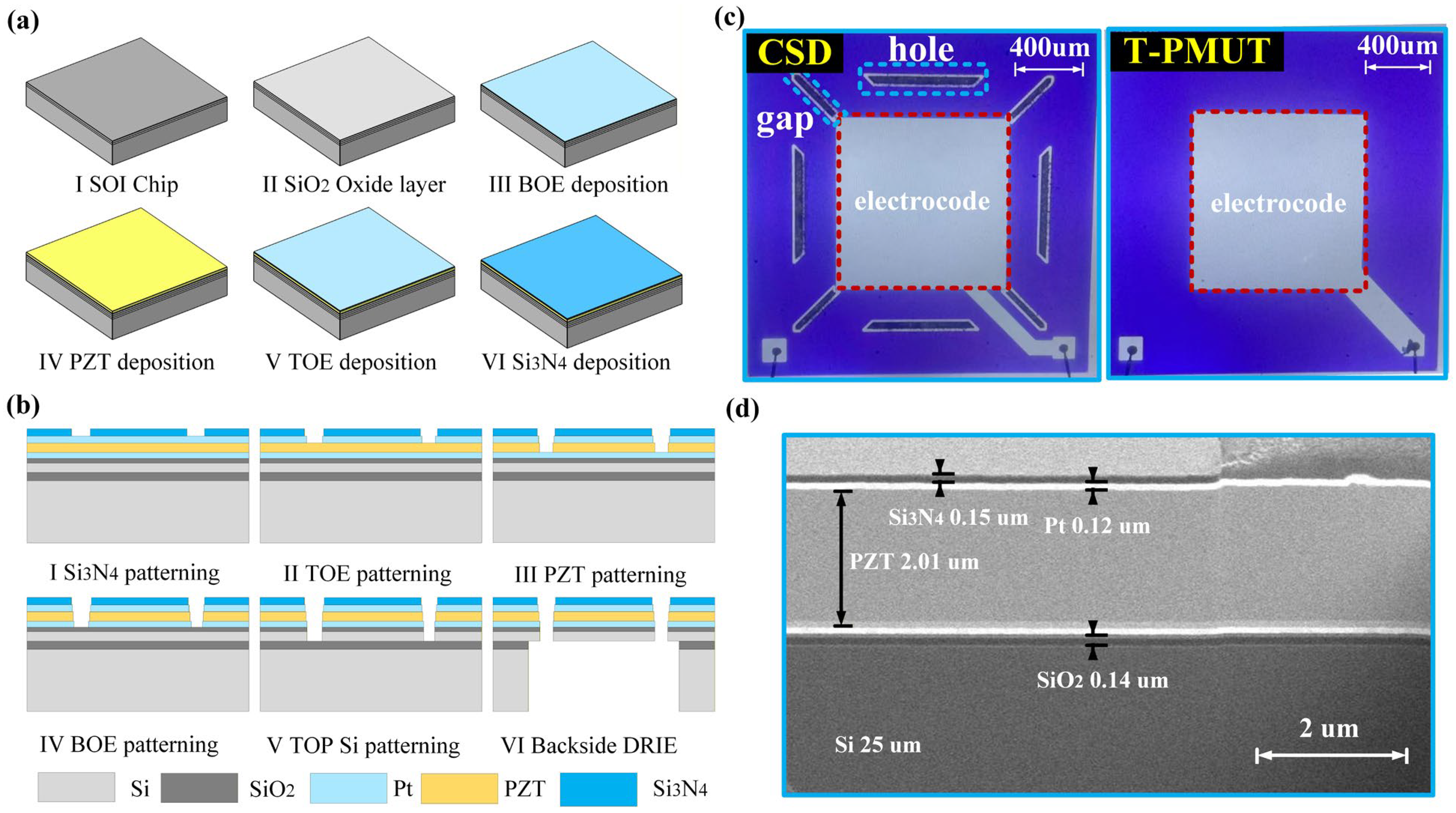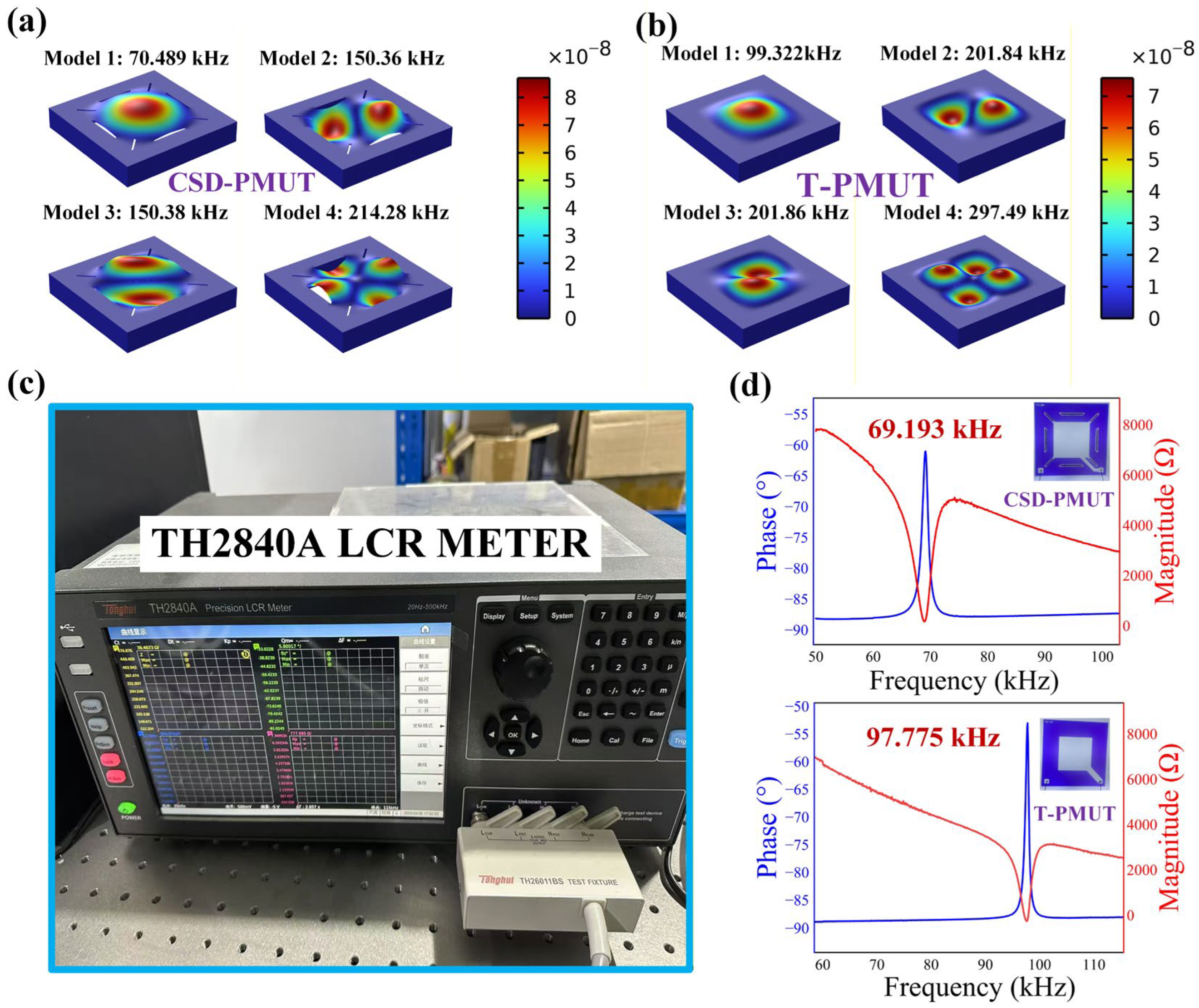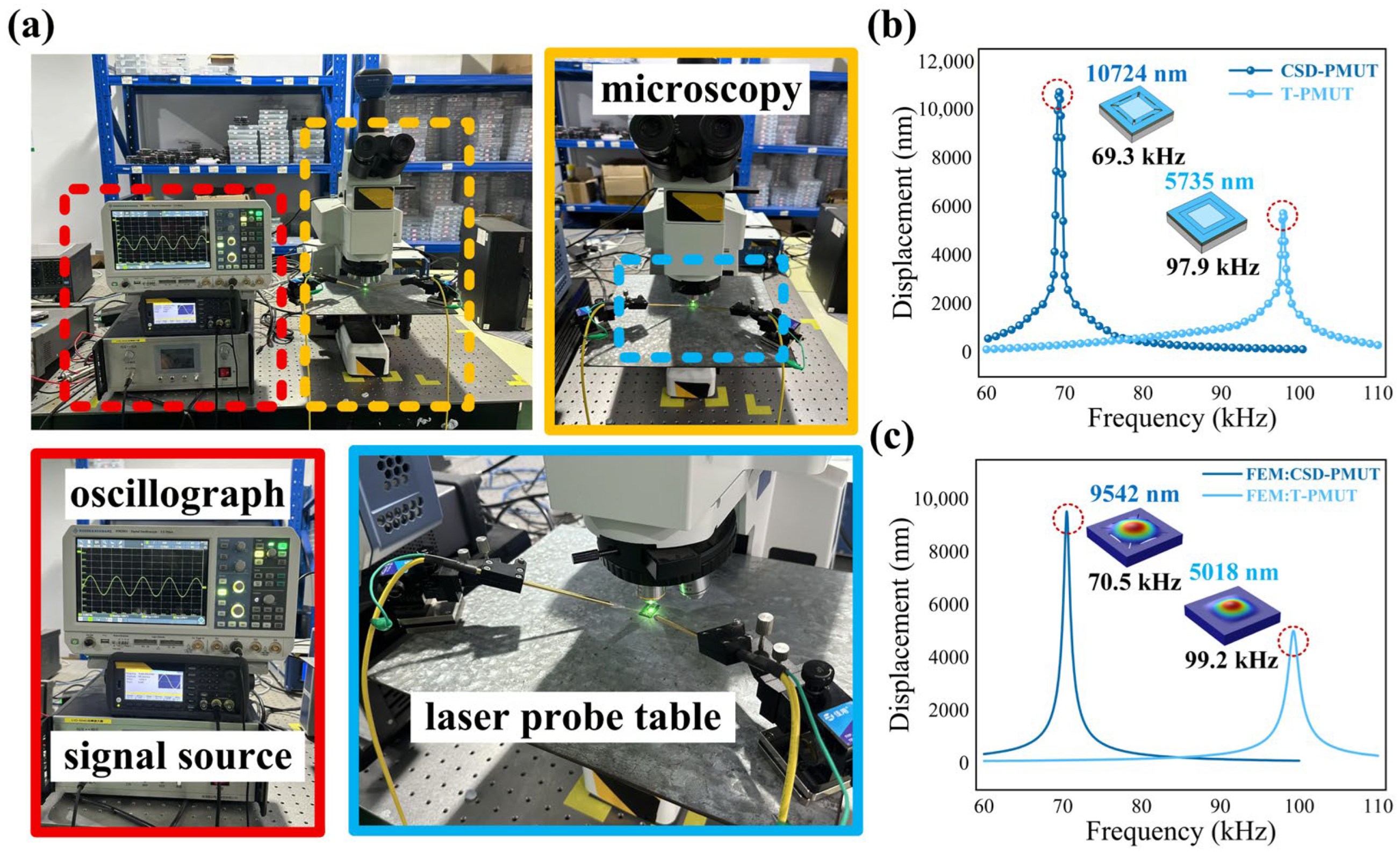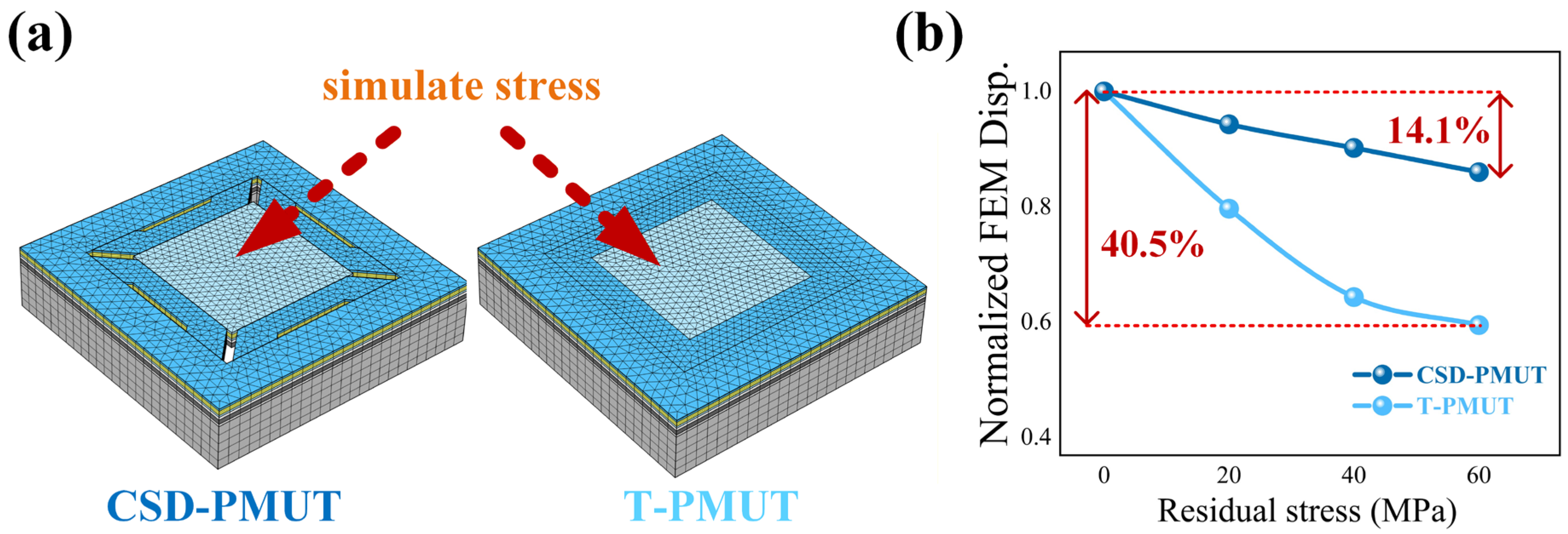Design, Fabrication, and Characterization of a Piezoelectric Micromachined Ultrasonic Transducer with a Suspended Cantilever Beam-like Structure with Enhanced SPL for Air Detection Applications
Abstract
1. Introduction
2. Materials and Methods
2.1. Device Design
2.2. Device Concept
2.3. Three-Dimensional Finite Element Simulation Research
2.4. Device Manufacturing
3. Results
3.1. Impedance and Modal Analysis
3.2. Resonant Displacement
3.3. Acoustic Performance
4. Discussion
5. Conclusions
Author Contributions
Funding
Data Availability Statement
Conflicts of Interest
References
- Pan, J.; Bai, C.; Zheng, Q.; Xie, H. Review of piezoelectric micromachined ultrasonic transducers for rangefinders. Micromachines 2023, 14, 374. [Google Scholar] [CrossRef]
- Yuan, Q.; Fan, L.; Tong, Z.; Yang, X.; Cao, Y. A study on time-voltage conversion method for pulse radar ranging. Mod. Radar 2012, 34, 69–73. [Google Scholar]
- Wu, J.; Yu, X.; Shi, S.; Zheng, L.; Sun, W. Infrared ranging technology by using single photon APD array readout integrated circuit. Infrared Laser Eng. 2017, 46, 69–74. [Google Scholar] [CrossRef]
- Wu, S.; Wei, Y.; Zhang, P.; Shen, Y.; Sun, X.; Wen, Z. Review of ultrasonic sensing techniques in micromachining applications. Adv. Mater. Technol. 2025, 10, e00169. [Google Scholar] [CrossRef]
- He, Y.; Wan, H.; Jiang, X.; Peng, C. Piezoelectric micromachined ultrasound transducer technology: Recent advances and applications. Biosensors 2023, 13, 55. [Google Scholar] [CrossRef] [PubMed]
- Birjis, Y.; Swaminathan, S.; Nazemi, H.; Raj, G.C.A.; Munirathinam, P.; Abu-Libdeh, A.; Emadi, A. Piezoelectric micromachined ultrasonic transducers (PMUTs): Performance metrics, advancements, and applications. Sensors 2022, 22, 9151. [Google Scholar] [CrossRef]
- Roy, K.; Lee, J.E.Y.; Lee, C. Thin-film PMUTs: A review of over 40 years of research. Microsyst. Nanoeng. 2023, 9, 95. [Google Scholar] [CrossRef]
- Tong, Z.; Hu, H.; Wu, Z.; Xie, S.; Chen, G.; Zhang, S.; Lou, L.; Liu, H. An ultrasonic proximity sensing skin for robot safety control by using piezoelectric micromachined ultrasonic transducers (PMUTs). IEEE Sens. J. 2022, 22, 17351–17361. [Google Scholar] [CrossRef]
- Yang, H.; Ji, M.; Xiu, X.; Lv, H.; Gu, A.; Zhang, S. AlScN film based piezoelectric micromechanical ultrasonic transducer for an extended long-range detection. Micromachines 2022, 13, 1942. [Google Scholar] [CrossRef]
- Luo, G.; He, K.; Wang, Y.; Zhou, W.; Chen, K.; Zhao, L.; Xu, T.; Li, Z.; Li, M.; Yang, P.; et al. Small blind-area, high-accuracy ultrasonic rangefinder using broadband multi-frequency piezoelectric micromachined ultrasonic transducers array. Meas. Sci. Technol. 2023, 34, 125140. [Google Scholar] [CrossRef]
- Shao, Z.C.; Pala, S.; Peng, Y.D.; Lin, L.W. Bimorph pinned piezoelectric micromachined ultrasonic transducers for space imaging applications. J. Microelectromech. Syst. 2021, 30, 650–658. [Google Scholar] [CrossRef]
- Shin, E.; Yeo, H.G.; Yeon, A.; Jin, C.; Park, W.; Lee, S.-C.; Choi, H. Development of a high-density piezoelectric micromachined ultrasonic transducer array based on patterned aluminum nitride thin film. Micromachines 2020, 11, 623. [Google Scholar] [CrossRef] [PubMed]
- Zhang, Y.; Miao, B.; Wang, G.; Zhou, H.; Zhang, S.; Hu, Y.; Wu, J.; Yu, X.; Li, J. ScAlN film-based piezoelectric micromechanical ultrasonic transducers with dual-ring structure for distance sensing. Micromachines 2023, 14, 516. [Google Scholar] [CrossRef]
- Ambacher, O.; Christian, B.; Feil, N.; Urban, D.F.; Elsässer, C.; Prescher, M.; Kirste, L. Wurtzite. ScAlN, InAlN, and GaAlN crystals: A comparison of structural, elastic, dielectric, and piezoelectric properties. J. Appl. Phys. 2021, 130, 045102. [Google Scholar] [CrossRef]
- Yao, S.; Shang, W.; Ta, G.; Tao, J.; Liu, H.; Zhao, X.; Liu, J. ScAlN PMUTs based on flexurally suspended membrane for long-range detection. Micromachines 2024, 15, 1377. [Google Scholar] [CrossRef] [PubMed]
- Wang, T.; Sawada, R.; Lee, C. A piezoelectric micromachined ultrasonic transducer using piston-like membrane motion. IEEE Electron. Device Lett. 2015, 36, 957–959. [Google Scholar] [CrossRef]
- Chen, X.; Chen, D.; Liu, X.; Yang, D.; Pang, J.; Xie, J. Transmitting sensitivity enhancement of piezoelectric micromachined ultrasonic transducers via residual stress localization by stiffness modification. IEEE Electron Device Lett. 2019, 40, 796–799. [Google Scholar] [CrossRef]
- Wang, Y.; Chen, P.; Zhang, J.; Li, Z.; Yu, H. Cantilever beam-based piezoelectric micromachined ultrasonic transducer with post-processing soft interconnecting strategy for in-air rangefinding. Microsyst. Nanoeng. 2025, 11, 97. [Google Scholar] [CrossRef]
- Hajati, A.; Emadi, A.; Chou, C.; Horsley, D.A. Three-dimensional micro electromechanical system piezoelectric ultrasound transducer. Appl. Phys. Lett. 2012, 101, 253101. [Google Scholar] [CrossRef]
- Zhang, Y.; Huang, C.; Gao, H. Design of AlN and PZT pMUT for high-quality ultrasound imaging. In Proceedings of the 2021 IEEE International Ultrasonics Symposium (IUS), Xi’an, China, 11–16 September 2021; pp. 1–3. [Google Scholar]
- Sammut, S.; Gatt, E.; Borg, R.P. Impact of radial electrode coverage on the performance of liquid-deployed PMUTs: A dynamic and kinematic study. Micromachines 2025, 16, 80. [Google Scholar] [CrossRef]
- Sammoura, F.; Kim, S.G. Theoretical modeling and equivalent electric circuit of a bimorph piezoelectric micromachined ultrasonic transducer. IEEE Trans. Ultrason. Ferroelectr. Freq. Control 2012, 59, 990–998. [Google Scholar] [CrossRef]
- Sammoura, F.; Smyth, K.; Kim, S.G. An equivalent network representation of a clamped bimorph piezoelectric micromachined ultrasonic transducer with circular and annular electrodes using matrix manipulation techniques. IEEE Trans. Ultrason. Ferroelectr. Freq. Control 2013, 60, 1989–2003. [Google Scholar] [CrossRef]
- Ji, M.; Yang, H.; Zhou, Y.; Xiu, X.; Lv, H.; Zhang, S. Bimorph dual-electrode ScAlN PMUT with two terminal connections. Micromachines 2022, 13, 2260. [Google Scholar] [CrossRef]
- Akhbari, S.; Sammoura, F.; Eovino, B.; Yang, C.; Lin, L. Bimorph piezoelectric micromachined ultrasonic transducers. J. Microelectromech. Syst. 2016, 25, 326–336. [Google Scholar] [CrossRef]
- Ren, Q.; Chen, J.; Liu, X.; Zhang, S.; Gu, Y. Design and 3D FEM analysis of a flexible piezoelectric micromechanical ultrasonic transducer based on Sc-doped AlN film. Sensors 2022, 22, 8100. [Google Scholar] [CrossRef]
- Liu, X.; Zhang, Q.; Chen, M.; Liu, Y.; Zhu, J.; Yang, J.; Wang, F.; Tang, Y.; Zhao, X. Multiphysics modeling and analysis of Sc-doped AlN thin film based piezoelectric micromachined ultrasonic transducer by finite element method. Micromachines 2023, 14, 1942. [Google Scholar] [CrossRef]
- Yu, B.; Yu, C.; Zhang, L.; Wang, Z.; Xu, X.; He, A.; Wang, X.; Niu, P.; Pang, W. Cost-effective strategy for developing small sized high frequency PMUTs toward phased array imaging applications. J. Microelectromech. Syst. 2023, 32, 164–172. [Google Scholar] [CrossRef]
- Xia, F.; Peng, Y.; Yue, W.; Luo, M.; Teng, M.; Chen, C.-M.; Pala, S.; Yu, X.; Ma, Y.; Acharya, M.; et al. High sound pressure piezoelectric micromachined ultrasonic transducers using sputtered potassium sodium niobate. Microsyst. Nanoeng. 2024, 10, 205. [Google Scholar] [CrossRef]
- Shao, Z.; Peng, Y.; Pala, S.; Liang, Y.; Lin, L. 3D ultrasonic object detections with >1 meter range. In Proceedings of the 2021 IEEE 34th International Conference on Micro Electro Mechanical Systems (MEMS), Gainesville, FL, USA, 25–28 January 2021; pp. 386–389. [Google Scholar]
- Jahren, S.E.; Aakvaag, N.; Strisland, F.; Vogl, A.; Liberale, A.; Liverud, A.E. Towards human motion tracking enhanced by semi-continuous ultrasonic time-of-flight measurements. Sensors 2021, 21, 2259. [Google Scholar] [CrossRef] [PubMed]
- Hong, Z.; Jianmin, M.; Zhihong, W.; Changlei, Z.; Weiguang, Z. Fabrication of ultrasonic arrays with 7 μm PZT thick films as ultrasonic emitter for object detection in air. Sens. Actuators A Phys. 2005, 123–124, 614–619. [Google Scholar]
- Luo, G.L.; Kusano, Y.; Horsley, D.A. Airborne piezoelectric micromachined ultrasonic transducers for long-range detection. J. Microelectromech. Syst. 2021, 30, 81–89. [Google Scholar] [CrossRef]
- Liu, T.; Zhang, J.; Li, D.; Wu, P.; Zhang, J.; Dou, H.; Zhang, M.; Yang, X.; Zhang, L.; Mu, X. Airborne rangefinding with pMUTs array using differential structure. IEEE Sens. J. 2023, 23, 22240–22247. [Google Scholar] [CrossRef]
- Chee, J.C.K.; Seshia, A.A. A review of piezoelectric micromachined ultrasonic transducers and their applications. J. Micromech. Microeng. 2017, 27, 031001. [Google Scholar]






| Symbol | Value | Description |
|---|---|---|
| H_PZT | 2 um | Thickness of piezoelectric layer |
| H_Si | 25 um | Thickness of vibrating layer of silicon |
| H_BOX | 1 um | Thickness of SOI buried oxygen layer |
| H_SUB | 400 um | Thickness of SOI silicon substrate |
| H_Pt | 0.1 um | Thickness of electrodes |
| H_SiO2 | 0.16 um | Thickness of the oxide layer |
| H_Si3N4 | 0.16 um | Thickness of the protective layer |
| Symbol | Value | Description |
|---|---|---|
| L_a | 2425 um | Side length of the PMUT |
| L_b | 1700 um | Side length of the cavity |
| L_c | 1190 um | Side length of the top electrode |
| L_u | 755 um | Length of the lower base of the trapezoidal hole |
| L_d | 655 um | Length of the upper base of the trapezoidal hole |
| W_Gap | 20 um | Width of the micro-gap |
| Symbol | Description | Value | Unit |
|---|---|---|---|
| YSi | Si Young’s modulus | 140 | GPa |
| vSi | Si Poisson’s ratio | 0.28 | 1 |
| YSiO2 | SiO2 Young’s modulus | 70 | GPa |
| YSi3N4 | Si3N4 Young’s modulus | 250 | GPa |
| e31PZT | PZT piezoelectric coefficient | −3.24 | C/m2 |
| rPZT | PZT density | 7750 | kg/m3 |
| rPt | Pt density | 21,450 | kg/m3 |
| rSiO2 | SiO2 density | 2200 | kg/m3 |
| Resonant Frequency | Piezoelectric Material | Upp [V] | Diaphragm Area [mm2] | Displacement [um] | Max Sound Pressure [Pa] | Reference |
|---|---|---|---|---|---|---|
| 69.3 kHz | PZT | 1 + −5 Vos | 1.7 | 10.7 | 4.004/10 cm/1 cell | This work |
| 95 kHz | PZT | 5 | 1.7 | / | 2.01/10 cm/1 cell | Ref. [31] |
| 58 kHz | PZT | 40 | 2.25 | 4.2 | 3.61/8 cm/1 cell | Ref. [32] |
| 48 kHz | S-C-PZT | 10 | 9 | 15 | 5.9/26 cm/4 cells | Ref. [33] |
| 69.2 kHz | ALN | 40 | 0.518 | / | 1.89/10 cm/1 cell | Ref. [18] |
| 80 kHz | ALN | 5 | 0.5 | 2.34 | 2.55/1 cm/1 cell | Ref. [34] |
Disclaimer/Publisher’s Note: The statements, opinions and data contained in all publications are solely those of the individual author(s) and contributor(s) and not of MDPI and/or the editor(s). MDPI and/or the editor(s) disclaim responsibility for any injury to people or property resulting from any ideas, methods, instructions or products referred to in the content. |
© 2025 by the authors. Licensee MDPI, Basel, Switzerland. This article is an open access article distributed under the terms and conditions of the Creative Commons Attribution (CC BY) license (https://creativecommons.org/licenses/by/4.0/).
Share and Cite
Ba, Y.; Li, Y.; Zhou, Y. Design, Fabrication, and Characterization of a Piezoelectric Micromachined Ultrasonic Transducer with a Suspended Cantilever Beam-like Structure with Enhanced SPL for Air Detection Applications. Micromachines 2025, 16, 1280. https://doi.org/10.3390/mi16111280
Ba Y, Li Y, Zhou Y. Design, Fabrication, and Characterization of a Piezoelectric Micromachined Ultrasonic Transducer with a Suspended Cantilever Beam-like Structure with Enhanced SPL for Air Detection Applications. Micromachines. 2025; 16(11):1280. https://doi.org/10.3390/mi16111280
Chicago/Turabian StyleBa, Yanyuan, Yiming Li, and Yuanhang Zhou. 2025. "Design, Fabrication, and Characterization of a Piezoelectric Micromachined Ultrasonic Transducer with a Suspended Cantilever Beam-like Structure with Enhanced SPL for Air Detection Applications" Micromachines 16, no. 11: 1280. https://doi.org/10.3390/mi16111280
APA StyleBa, Y., Li, Y., & Zhou, Y. (2025). Design, Fabrication, and Characterization of a Piezoelectric Micromachined Ultrasonic Transducer with a Suspended Cantilever Beam-like Structure with Enhanced SPL for Air Detection Applications. Micromachines, 16(11), 1280. https://doi.org/10.3390/mi16111280





